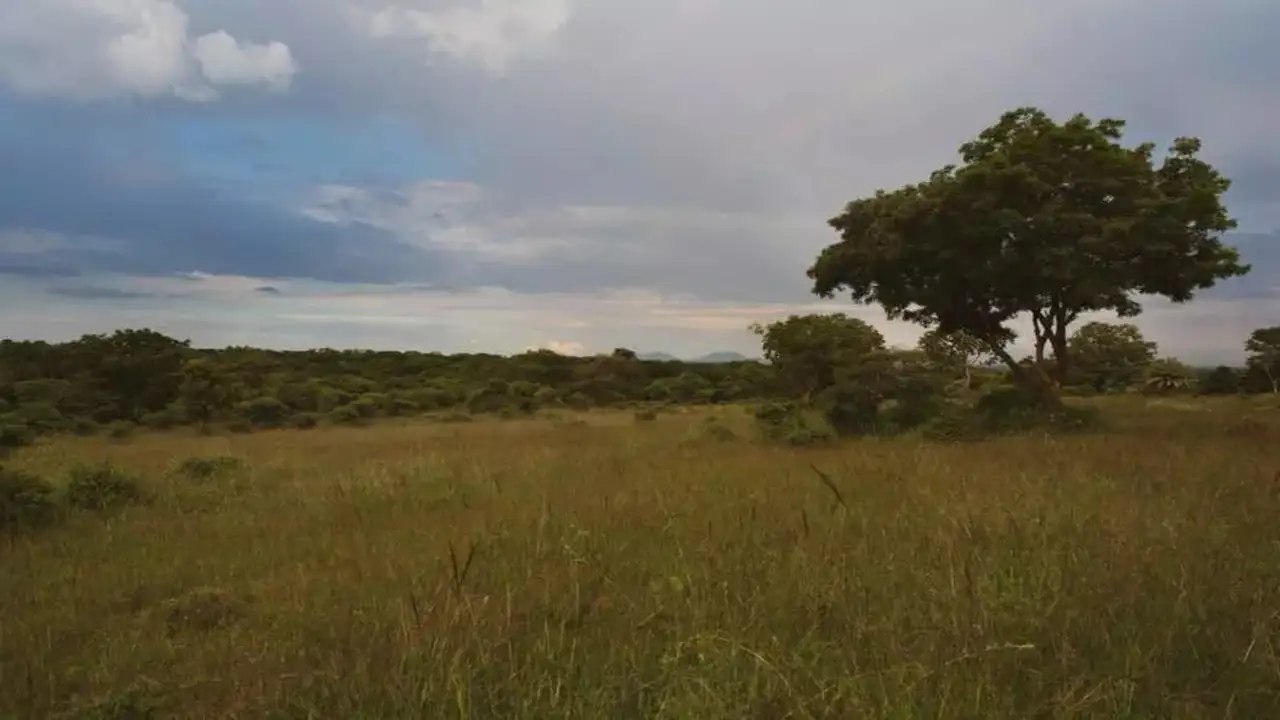- Courses
- GS Full Course 1 Year
- GS Full Course 2 Year
- GS Full Course 3 Year
- GS Full Course Till Selection
- Online Program
- GS Recorded Course
- NCERT (Recorded 500+ Hours)
- Polity Recorded Course
- Geography Recorded Course
- Economy Recorded Course
- AMAC Recorded Course
- Modern India, Post Independence & World History
- Environment Recoded Course
- Governance Recoded Course
- Science & Tech. Recoded Course
- International Relations and Internal Security Recorded Course
- Disaster Management Module Course
- Ethics Recoded Course
- Essay Recoded Course
- Current Affairs Recoded Course
- CSAT
- 5 LAYERED ARJUNA Mentorship
- Public Administration Optional
- ABOUT US
- OUR TOPPERS
- TEST SERIES
- FREE STUDY MATERIAL
- VIDEOS
- CONTACT US
PLACES IN NEWS 10 DECEMBER 2024
PLACES IN NEWS 10 DECEMBER 2024
10-12-2024
Kanha National Park
Why in news?
- A tiger from Kanha National Park (KNP) in Madhya Pradesh has traveled 450 km to Achanakmar Tiger Reserve (ATR) in Chhattisgarh, identified as T-200 by the Wildlife Institute of India (WII). It was first spotted in ATR's Lamni range and now roams the Manendragarh forest division.
About Kanha National Park:
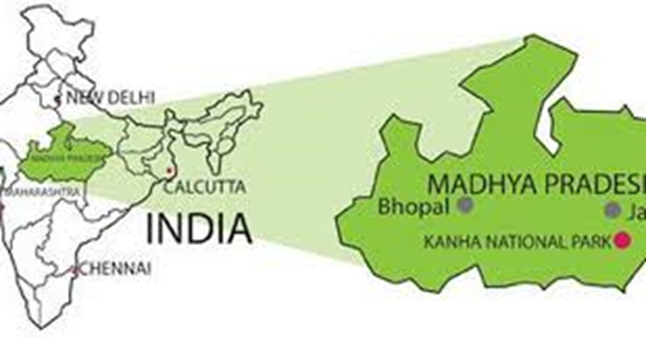
- Kanha National Park is located in Madhya Pradesh. It was established in 1955 and later, in 1973, became a part of the Project Tiger initiative for the conservation of endangered Bengal tigers.
- Spread over 940 square kilometres, the national park forms the core of the Kanha Tiger Reserve, which extends to 1,949 square kilometres, including buffer zones.
- The park is situated in the Maikal Hills of the Satpura range, covering two districts—Mandla and Balaghat.
- Its diverse topography includes flatlands, gentle slopes, dense forests, meadows, and riverine areas.
- Its primary rivers are the Banjar and the Halon, which contribute to the park’s lush ecosystem.
-
Flora:
- Kanha is renowned for its dense sal (Shorea robusta) and bamboo forests, interspersed with rolling grasslands and meadows.
- Its varied vegetation supports a thriving ecosystem. Species like mahua, dhawa, and palash dominate the park, with the meadows serving as prime grazing grounds for herbivores.
-
Fauna:
- The park is home to the iconic Bengal tiger, Indian leopards, sloth bears, and Indian wild dogs (dholes).
- Herbivores like barasingha (swamp deer), spotted deer, and sambar deer are prevalent, with Kanha famously reviving the threatened barasingha population.
- Over 300 bird species, including peacocks, drongos, and eagles, enrich the park’s biodiversity. Reptiles and amphibians like pythons, cobras, and frogs also inhabit the park.
About Achanakmar Tiger Reserve:
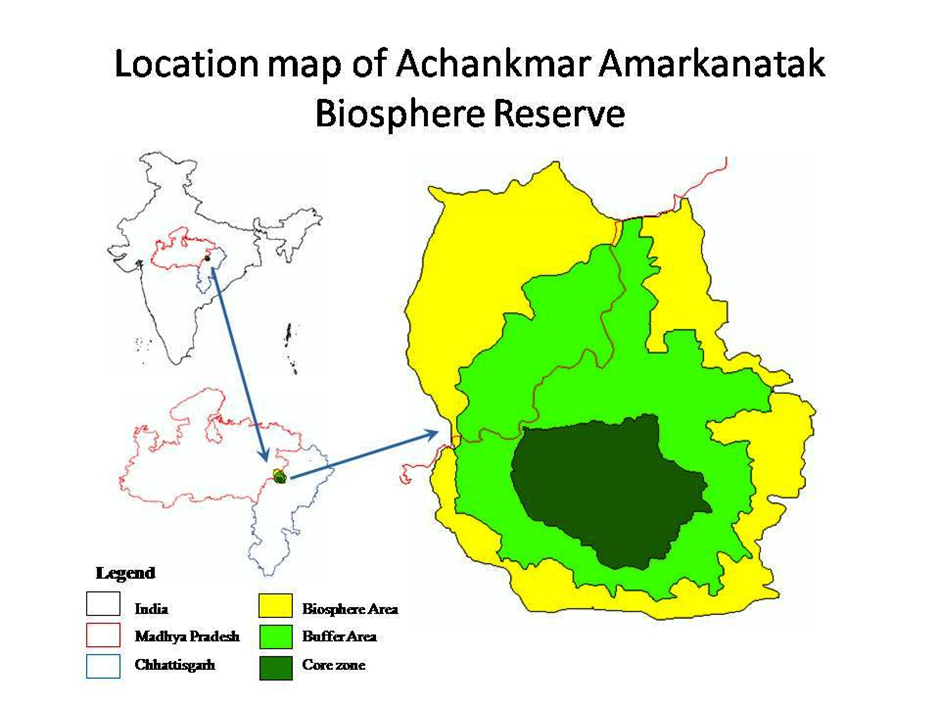
- Achanakmar Tiger Reserve (ATR) is located in Chhattisgarh.
- It was established in 1975 and declared a part of the Project Tiger initiative in 2009.
- It spans an area of 914 square kilometres and forms part of the Achanakmar-Amarkantak Biosphere Reserve.
- It is situated in the Maikal Hills of the Satpura range that features a diverse landscape of dense forests, streams, and undulating terrain.
- The Maniyaar River flows through the reserve, enriching its ecosystem. The tiger reserve connects to the Kanha Tiger Reserve in Madhya Pradesh through a wildlife corridor, vital for tiger movement.
- Flora: The reserve's vegetation is dominated by sal, teak, and bamboo, with a mix of dry deciduous and tropical moist forests. Medicinal plants are abundant.
- Fauna: The tiger reserve is home to the Bengal tiger, leopards, sloth bears, and Indian gaur. It supports herbivores like spotted deer and sambar and harbours over 200 bird species, including hornbills and peacocks.
Schengen free-travel area
Why in news?
- Austria has lifted its veto on Romania and Bulgaria's full membership in the Schengen free-travel area, paving the way for the European Union's interior ministers to approve their inclusion at an upcoming meeting.
- Romania and Bulgaria, EU and NATO (North Atlantic Treaty Organisation) members, were partially integrated into Schengen in March 2024, which eased their air and maritime border restrictions.
- However, land access discussions continued, initially stalled by Austria's concerns over illegal immigration.
- Austrian Interior Minister Gerhard Karner cited a significant drop in illegal border crossings as a key factor in the policy shift and expressed optimism about confirming the progress at the EU Justice and Home Affairs Council.
About Schengen Area:
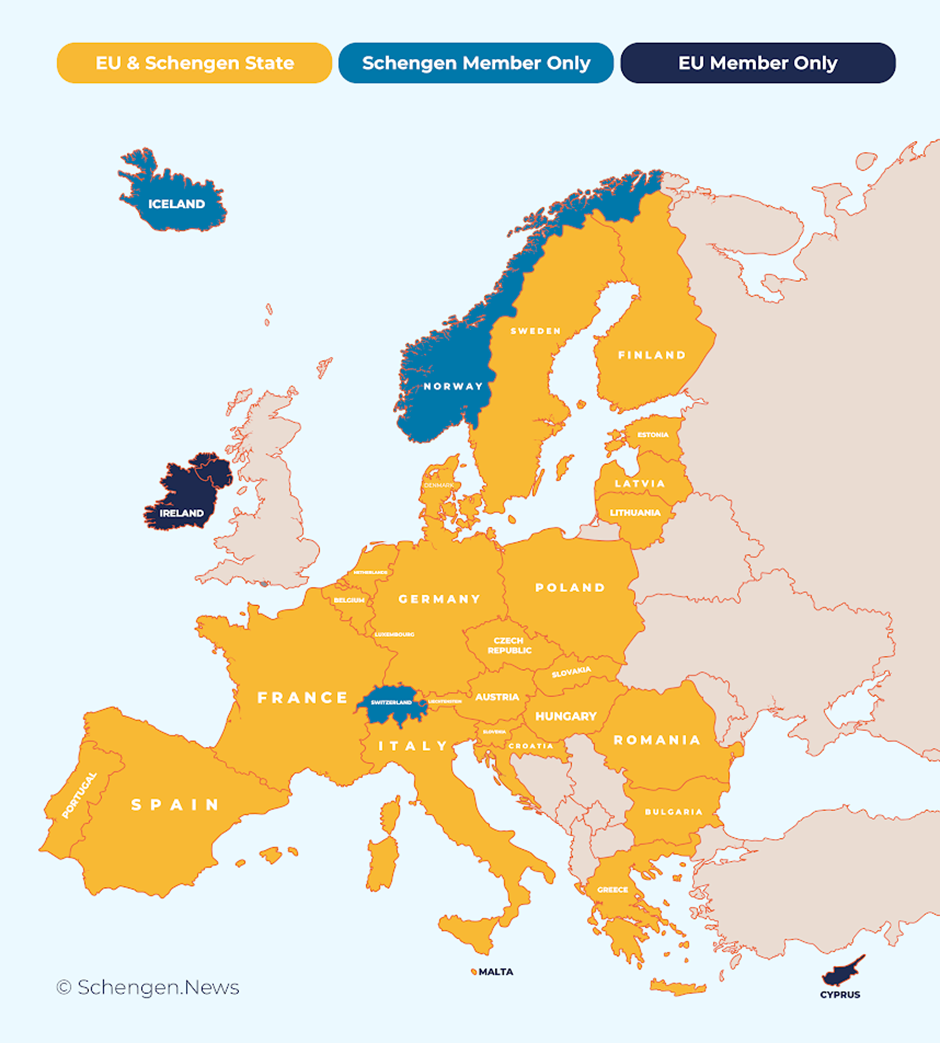
- The Schengen Area is a framework of 29 European countries that have abolished internal border controls, enabling passport-free travel across the member states.
- This supports the free movement of people, goods, services, and capital, fostering economic and social integration.
- The legal foundation of the Schengen Area is rooted in both EU treaties and earlier agreements. The Treaty of Amsterdam inserted the legal basis into the Treaty establishing the European Community, creating a new title, "Visas, asylum, immigration, and other policies related to the free movement of persons," currently referred to as the "Area of Freedom, Security, and Justice" under the Treaty of Lisbon.
- This area comprises five chapters, including border policies, judicial cooperation, and police cooperation, solidifying shared security and mobility policies.
- The Schengen Area originated outside the European Union through two agreements: the 1985 Schengen Agreement, involving the Benelux countries (Belgium, Netherlands, Luxembourg), France, and Germany, aimed at gradually abolishing border checks; and the 1990 Schengen Convention, which implemented the agreement. These agreements were later incorporated into EU law through the Amsterdam Treaty, allowing further amendments via EU regulations.
-
Countries in the Schengen Area:
The Schengen Area includes 29 countries: Austria, Belgium, Bulgaria, Croatia, Cyprus, Czech Republic, Denmark, Estonia, Finland, France, Germany, Greece, Hungary, Iceland, Italy, Latvia, Liechtenstein, Lithuania, Luxembourg, Malta, Netherlands, Norway, Poland, Portugal, Romania, Slovakia, Slovenia, Spain, Sweden, and Switzerland. Romania and Bulgaria recently achieved full integration. - Non-Schengen EU Countries: Ireland has opted out of Schengen, while Cyprus is awaiting integration.
- Non-EU Countries in Schengen: Iceland, Norway, Switzerland, and Liechtenstein are members of Schengen but not of the EU.
Haiti
Why in news?
- Over the weekend, more than 180 people were killed in Haiti's Port-au-Prince, particularly in the Cite Soleil area, during a violent spree reportedly orchestrated by a gang leader blaming voodoo practitioners for his son’s illness.
- Elderly individuals and voodoo practitioners were targeted, with victims executed, mutilated, and burned. Motorcycle taxi drivers attempting rescues were also killed. The attacks highlight escalating violence in a city largely dominated by gangs.
- UN Secretary-General António Guterres condemned the brutality and called for an investigation, urging international support for Haitian authorities.
- The violence has displaced over 5,000 people, adding to Haiti's 700,000 internally displaced population this year.
About Haiti:
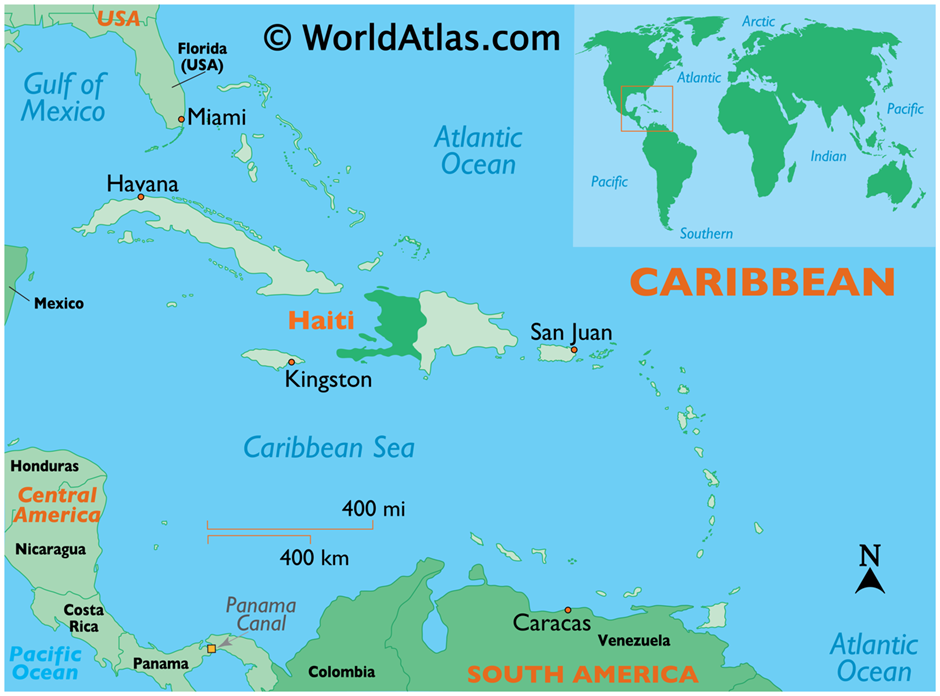
- Haiti is located in the Caribbean islands, occupying the western third of the island of Hispaniola, which it shares with the Dominican Republic.
- It is bordered by the Atlantic Ocean to the north and the Caribbean Sea to the south and spans across an area of approximately 27,750 square kilometres.
- The country's geophysiography is marked by rugged mountains, with the Massif de la Hotte and Massif de la Selle forming the highest regions, reaching up to 2,680 meters at Pic la Selle, the nation's highest peak.
- Plains and valleys, such as the Cul-de-Sac Plain, provide limited arable land, essential for Haiti's agriculture-dependent economy.
- Haiti also experiences a tropical climate, with variations due to altitude and frequent hurricanes affecting the region.
- Haiti is grappling with widespread violence and instability, driven by escalating gang activity. Over 200 armed groups are reported to control significant portions of the country, particularly in the capital, Port-au-Prince.
- Kidnappings for ransom, extortion, and targeted attacks have surged, with gangs frequently blocking major transportation routes, including vital fuel and food supplies, leading to acute shortages.
- Political instability has further fuelled violence, especially after the assassination of President Jovenel Moïse in 2021. The absence of a fully functioning government has created a power vacuum, allowing gangs to operate with impunity.
- Humanitarian crises are deepening, with nearly 5 million Haitians requiring urgent assistance due to food insecurity, displacement, and limited access to basic services. The international community, including the United Nations (UN), has called for urgent intervention to address the escalating crisis.
Kaliningrad
Why in news?
- India and Russia are advancing their cooperation in Artificial Intelligence, cybersecurity, space exploration, and counter-terrorism, said Defence Minister Rajnath Singh at the commissioning of INS Tushil in Kaliningrad, Russia.
- INS Tushil, the seventh in the Krivak III-class frigates, exemplifies India’s technological growth and collaboration with Russia.
- INS Tushil is designed for blue-water operations across naval warfare dimensions, equipped with advanced weaponry, enhancing India's role as a maritime security provider.
About Kaliningrad:
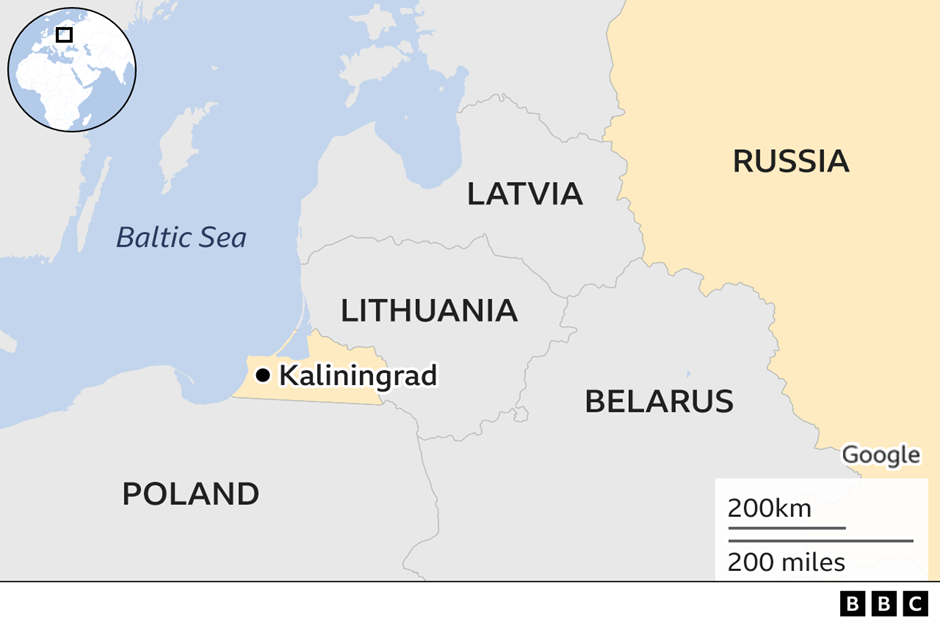
- Kaliningrad, a Russian exclave, is located on the Baltic Sea, bordered by Poland to the south and Lithuania to the north and east, making it geographically separated from mainland Russia.
- Its strategic position between NATO and EU member states provides Russia with direct access to the Baltic Sea and a vital foothold in Europe.
- Historically, Kaliningrad was known as Königsberg and was part of Prussia and later Germany until 1945. It became part of the Soviet Union after World War II, following the Potsdam Conference, where Allied powers agreed to its transfer.
- Kaliningrad is home to the Baltic Fleet, one of Russia’s most significant naval forces, underscoring its military importance. The fleet enhances Russia’s ability to project power in the Baltic region and counterbalance NATO's presence.
- As a heavily militarised region, it hosts advanced missile systems, including the Iskander-M, which is capable of delivering nuclear and conventional strikes, reinforcing its role in Russia’s defence strategy.
- Politically, Kaliningrad plays a key role in Russia's relations with NATO and the EU. Its location often fuels geopolitical tensions, especially regarding military deployments and security concerns in Eastern Europe.
- Economically, it serves as a trade hub and a key port, facilitating Russia’s exports and imports in the Baltic region. The Kaliningrad Special Economic Zone was established to attract investment and boost development.
Gulf of Mexico
Why in news?
- Researchers from Texas A&M University-Corpus Christi have detected pharmaceuticals, including fentanyl, in the blubber of bottlenose dolphins in the Gulf of Mexico, raising concerns about drug contamination in marine environments.
- Tissue samples from 89 dolphins revealed traces of fentanyl, sedatives, and muscle relaxants, with some dating back to 2013.
- Dolphins, as apex predators and bioindicators, likely acquire these drugs through diet or skin absorption. Chronic exposure to such contaminants, alongside other human-caused stressors like pollution and climate change, poses risks to marine mammal health and reproduction.
- Researchers call for large-scale studies to address the growing issue of pharmaceutical pollution.
About Gulf of Mexico:
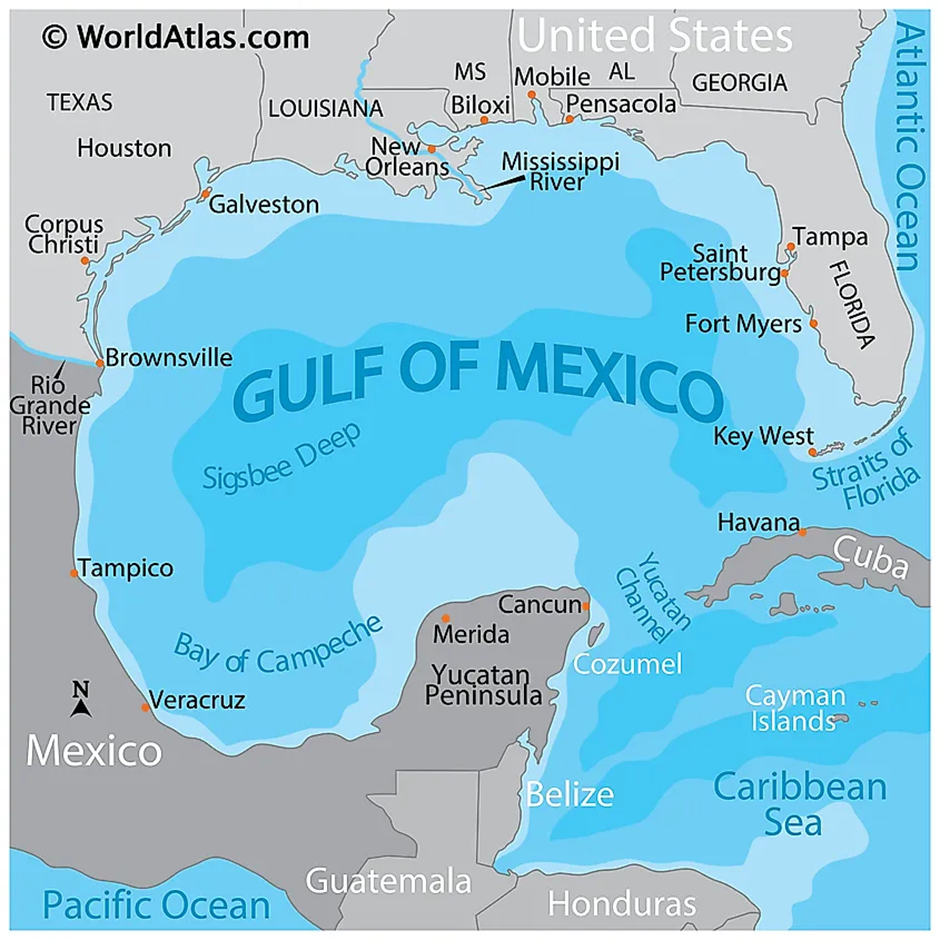
- The Gulf of Mexico, a marginal sea of the Atlantic Ocean, is bordered by the United States to the north, Mexico to the west and south, and Cuba to the southeast.
- Encompassing approximately 1.6 million square kilometres, it is a semi-enclosed body of water connected to the Atlantic via the Straits of Florida and to the Caribbean Sea through the Yucatán Channel.
- the Gulf plays a vital role in global ocean circulation. The Loop Current, a major current within the Gulf, feeds into the Gulf Stream, influencing weather and climate patterns far beyond its boundaries. Its waters are shallow on the northern continental shelf, deepening dramatically in the Sigsbee Deep, which is a central abyss reaching depths of over 4,000 meters.
- The Gulf experiences a warm temperate eastern margin climate, characterised by high humidity, warm summers, and mild winters. Sea surface temperatures, which average 23-29°C, support a rich and diverse marine ecosystem.
- This climate, however, also contributes to its vulnerability to hurricanes, particularly during the Atlantic hurricane season from June to November, often resulting in significant economic and environmental impacts.
- Twisters or waterspouts occasionally form over the Gulf's warm waters, especially in late summer and early autumn, associated with intense thunderstorms. These phenomena highlight the dynamic weather patterns linked to the region’s unique geography and climate.
- The Gulf of Mexico boasts remarkable biodiversity, hosting ecosystems such as coral reefs, estuaries, and seagrass beds. It is home to numerous species of fish, marine mammals, seabirds, and invertebrates.
- The Mississippi River delta, which drains into the Gulf, creates nutrient-rich waters that support some of the world’s most productive fisheries.
- Industrially, the Gulf is a powerhouse. It supports major oil and gas extraction industries, with offshore drilling rigs dotting its waters. Fisheries, especially shrimp and oyster industries, are economically vital. Additionally, the region has historical ties to the cotton industry, with ports in the Gulf acting as major export hubs during the cotton trade's peak.
UPSC CSE PYQsQ1. Which one of the following protected areas is well-known for the conservation of a subspecies of the Indian swamp deer (Barasingha) that thrives well on hard ground and is exclusively graminivorous? (2020)
Answer: Option A |



